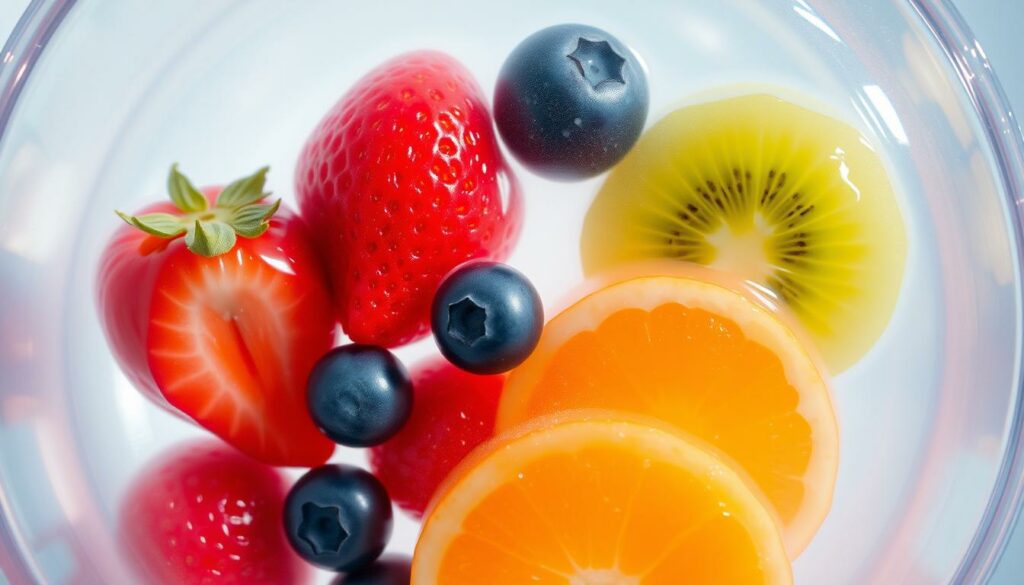I love gelatin, and I’ve always been curious about what fruits go well with it. From fun childhood treats to fancy dinner desserts, gelatin brings joy and memories. But, which fruits are the best to use?
In this guide, we’ll dive into the world of gelatin and find the perfect fruit matches. Whether you’re making desserts often or just starting, this article will help you create amazing gelatin treats. Your taste buds will thank you.
Table of contents
Key Takeaways
- Understand the chemical structure and properties of gelatin and how it interacts with different foods.
- Discover the best fruits for gelatin desserts, including berries, stone fruits, and citrus options.
- Learn which fruits to avoid and why, as well as special considerations for tropical fruits.
- Explore tips and techniques for creating perfect fruit-filled gelatin treats.
- Discover the health benefits of incorporating fruit-based gelatin desserts into your diet.
Understanding Gelatin and Its Properties
Gelatin is a protein made from collagen, used in many desserts and foods. Knowing how gelatin works is key when using fruit for gelatin molds or picking the best fruits for gelatin recipes.
Chemical Structure of Gelatin
Gelatin is made of amino acids in a special triple-helix shape. This shape lets gelatin turn into a gel when mixed with liquid and cooled. The gel’s strength and stability depend on the gelatin’s source, how it’s processed, and its molecular weight.
How Gelatin Interacts with Different Foods
Gelatin reacts differently with foods, especially fruits. The fruit’s acidity, enzyme content, and sugar levels matter. Acidic fruits like citrus or pineapple can mess with gelatin’s gelling. Fruits with enzymes, like kiwi or papaya, can break down gelatin. Knowing these interactions helps make great fruit for gelatin molds and best fruits for gelatin desserts.
Temperature Considerations for Gelatin Setting
The temperature at which gelatin sets is very important. It usually sets best between 32-40°F (0-4°C). Keeping the right temperature during preparation and cooling is key for the best fruits for gelatin recipes to turn out right.
“Gelatin is a unique and versatile ingredient that can transform ordinary desserts into works of art. Understanding its chemical properties and interactions with other foods is key to unlocking its full potential in the kitchen.”
What Fruit Can Be Used in Gelatin?
Creating fruit gelatin salads or gelatin fruit cups is fun. You can use many fruits in these desserts. Most berries, stone fruits, and citrus fruits are great choices.
Berries like strawberries, blueberries, raspberries, and blackberries are favorites. They’re sweet and colorful, perfect for gelatin. Stone fruits like peaches, nectarines, and plums add a nice tartness and texture.
Citrus fruits like oranges, grapefruits, and lemons bring a refreshing twist. Their tangy taste balances the sweetness of the gelatin, making a beautiful dessert.
But, some fruits like pineapple and papaya need special care. They have enzymes that can stop the gelatin from setting. Cooking or canning them first can help.
Choosing the right fruit for your gelatin dessert is up to you. It depends on what you like, the flavor you want, and the recipe. Trying different fruits can make your gelatin salads and cups look and taste amazing.
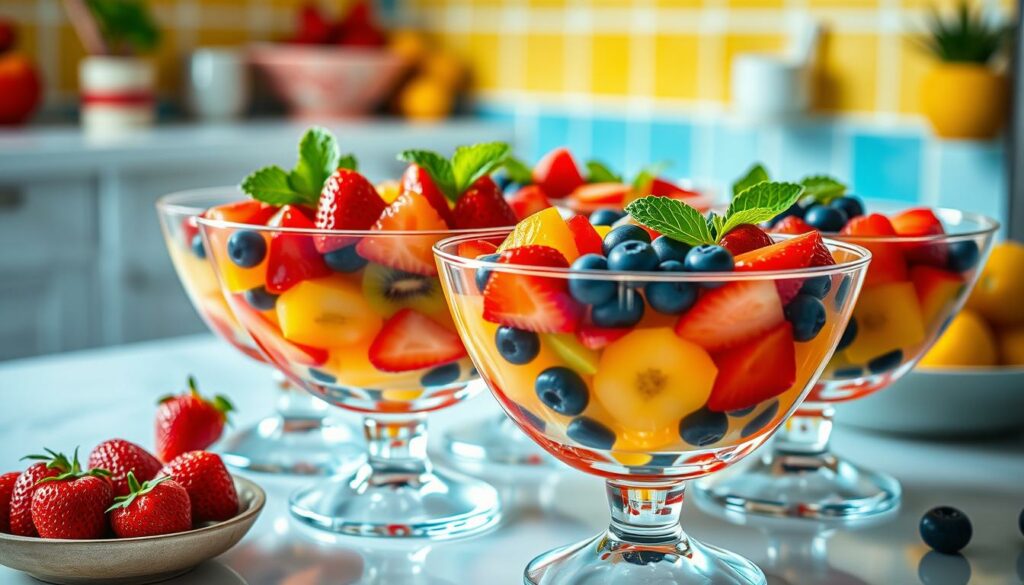
| Fruit | Suitability for Gelatin |
|---|---|
| Berries | Excellent |
| Stone Fruits | Excellent |
| Citrus Fruits | Excellent |
| Tropical Fruits (Pineapple, Papaya) | Requires special preparation |
Fresh Fruits That Work Best in Gelatin Desserts
Choosing the right fresh fruit is key to making great gelatin desserts. Some fruits stay fresh and flavorful in gelatin. Let’s look at the top fruits for gelatin treats.
Berries and Small Fruits
Berries like strawberries, raspberries, and blueberries are perfect for gelatin desserts. They keep their shape and add sweetness and color.
Stone Fruits
Stone fruits like peaches, plums, and cherries are also great. Their firm texture and juicy flesh pair well with gelatin.
Citrus Options
For a refreshing twist, try citrus fruits like oranges and grapefruits. Their tangy flavors contrast nicely with sweet gelatin.
Remember, choose fresh, ripe fruits for the best results. With the right mix of gelatin with fresh fruit, you can make stunning best fruits for gelatin desserts.
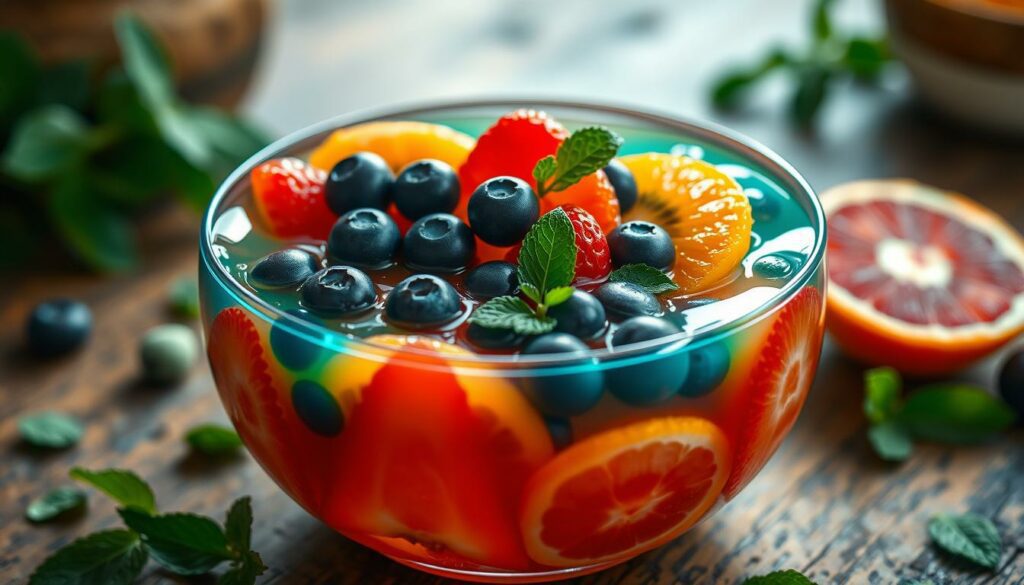
“Gelatin desserts are a classic treat that allow the natural sweetness and textures of fresh fruits to shine.”
Fruits to Avoid in Gelatin Recipes
Creating fruit gelatin desserts can be fun, but some fruits are better left out. This is because certain fruits have enzymes that can mess with the gelatin. This makes it hard for the gelatin to set right.
Fresh pineapple, kiwi, and papaya are fruits to use with caution. They have enzymes that can stop the gelatin from setting. But, there’s a fix. Use canned or cooked versions of these fruits instead of fresh.
Canning or cooking these fruits kills the enzymes. This lets the gelatin set as it should. This trick makes your fruit gelatin recipes always come out right.
So, choose your fruits wisely for your next gelatin dessert. Opt for berries, citrus, and other fruits without enzymes. With a bit of knowledge, you can make gelatin desserts that look great and taste amazing.
| Fruit | Enzyme Activity | Recommended Form |
|---|---|---|
| Pineapple | High | Canned or cooked |
| Kiwi | High | Canned or cooked |
| Papaya | High | Canned or cooked |
| Berries | Low | Fresh or frozen |
| Citrus | Low | Fresh or canned |
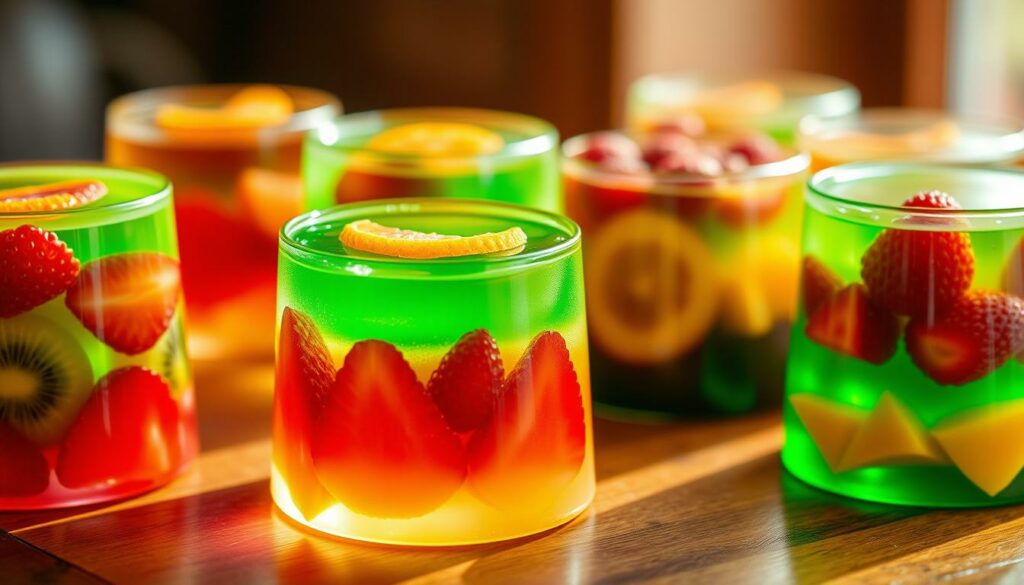
For perfect fruit gelatin desserts, know which fruits to use and how to prepare them. Avoid fruits with enzymes and follow the right steps. This way, you can make gelatin desserts that look stunning and taste great, impressing everyone.
Tropical Fruits and Their Special Considerations
When using tropical fruits for gelatin, there are key things to remember. Some tropical fruits can make gelatin hard to set because of their chemical makeup.
Pineapple and Papaya Precautions
Fresh pineapple and papaya have enzymes that can mess with gelatin’s setting. This can make your dessert too runny. To fix this, use canned pineapple and papaya instead. The canning process kills the enzymes that cause trouble.
Mango and Coconut Applications
Mangoes and coconut are great for gelatin desserts. They add unique flavors and textures that work well with gelatin. Try using pureed mango or shredded coconut to make your gelatin molds taste like the tropics.
“Tropical fruits add a refreshing and exotic twist to classic gelatin desserts, but you need to be mindful of their special characteristics to ensure a successful outcome.”
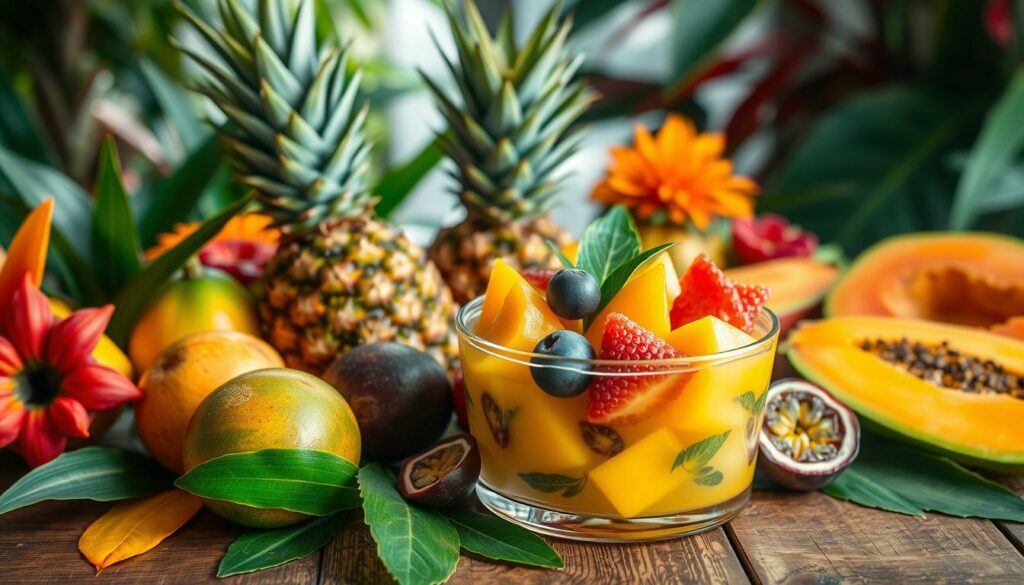
Knowing how to use tropical fruits in gelatin can open up a world of tasty desserts. Dive into the vibrant flavors and textures of the tropics. Create fruit for gelatin molds that will wow your guests.
Canned vs Fresh Fruit in Gelatin
Choosing between gelatin desserts with fruit from cans or fresh is a big decision. Canned fruits are easy to use and sweetened already. But, fresh fruits give a lively texture and taste that many love.
Canned fruits are great for fruit gelatin salads because they don’t have bad enzymes. This helps the gelatin set better, making the dessert firmer and more consistent.
| Canned Fruits | Fresh Fruits |
|---|---|
|
|
Even though canned fruits are easier to use, many people choose gelatin desserts with fresh fruit for their taste and health benefits. It all depends on what you like, how much you want to spend, and what your recipe needs.
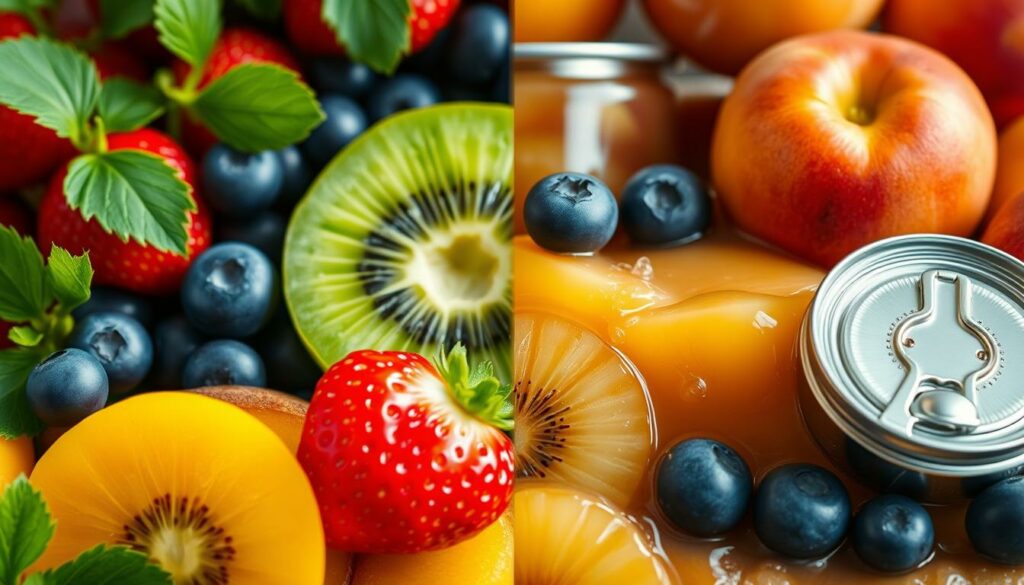
“The bright, natural flavors of fresh fruit in gelatin can truly elevate a dessert and make it stand out.”
Whether you pick canned or fresh, adding different fruits to your gelatin desserts makes them look and taste amazing. Your family and friends will love them.
Tips for Perfect Fruit Gelatin Desserts
Making fruit gelatin desserts is an art that needs focus. You must pay attention to layering and temperature control. These tips will help you make fruit gelatin cups that look great and taste amazing.
Proper Layering Techniques
Layering is key to making stunning fruit gelatin desserts. Start by pouring a thin layer of set gelatin into your containers. Chill it until it’s firm. This is the base of your dessert.
Next, arrange your fresh fruit on top, making sure it’s spread out evenly. Slowly pour the rest of the gelatin over the fruit. Chill each layer until it’s set before adding the next. This prevents the fruit from sinking.
Temperature Control Methods
Controlling the temperature is vital for perfect fruit gelatin desserts. When mixing gelatin, follow the instructions carefully. Make sure the water is at the right temperature.
After dissolving the gelatin, let it cool a bit before adding fruit. This keeps the fruit’s shape and texture. Chilling the gelatin mixture between layers makes it smooth and even.
Mastering layering and temperature control lets you create fruit gelatin recipes and gelatin fruit cups that are beautiful and full of flavor.
Creative Fruit Gelatin Combinations
Creating tasty fruit gelatin recipes and gelatin desserts with fruit is a fun adventure. Try mixing different fruits to make something new and exciting. For example, berries with citrus or tropical fruits with stone fruits can be amazing.
For a beautiful dessert, play with colors. Mix bright berries with lemon or orange gelatin. Or, add mango, pineapple, and kiwi to coconut gelatin for a tropical look.
Be bold with your fruit choices. Try pairing tart cranberries with sweet peaches or juicy plums with vanilla. The goal is to mix flavors and textures well in your fruit gelatin desserts.
| Fruit Combination | Flavor Profile | Serving Suggestion |
|---|---|---|
| Strawberries and Kiwi | Sweet and Tart | Serve in individual parfait glasses for a refreshing treat |
| Blueberries and Lemon | Bright and Tangy | Layer in a clear glass bowl for a vibrant display |
| Mango, Pineapple, and Coconut | Tropical and Creamy | Serve in a hollowed-out pineapple shell for a fun presentation |
Creating outstanding fruit gelatin recipes is all about having fun and being creative. Don’t be afraid to mix and match fruits, flavors, and colors. This way, you can make truly unique and delicious gelatin desserts with fruit.
Seasonal Fruit Selection Guide
Choosing seasonal fruits is key to making delicious gelatin desserts. It’s all about using nature’s best to create amazing fruit gelatin molds.
Summer Fruit Options
In summer, your gelatin can get a boost from fresh and colorful fruits. Try adding juicy berries like strawberries, raspberries, and blueberries for sweetness and color. Stone fruits like peaches, nectarines, and apricots add soft texture and summer flavors.
Melons, including watermelon and cantaloupe, are great for a light and refreshing gelatin base.
Winter Fruit Choices
In winter, choose fruits that warm your heart. Citrus fruits like oranges, grapefruits, and mandarins add a bright and zesty touch. Pomegranate seeds bring a burst of ruby-red color and texture.
Canned pineapple or mango can add a tropical flavor. Pears and apples, whether poached or fresh, are perfect for winter gelatin molds.
By using seasonal fruits in your gelatin recipes, you can enjoy a variety of desserts all year. From summer berries to winter citrus, the options are endless.
“Gelatin is a versatile ingredient that can transform seasonal fruits into something truly special. By pairing the right fruits with the right gelatin, you can create desserts that are not only visually stunning but also bursting with flavor.”
Troubleshooting Common Gelatin Issues
Working with what fruit can be used in gelatin? and gelatin with fresh fruit can sometimes be tricky. Knowing how to fix common problems can make your fruit-infused gelatin desserts perfect every time.
One big issue is when the gelatin doesn’t set right. This might happen if you use the wrong gelatin-to-liquid ratio or don’t chill it enough. To fix this, check your recipe and make sure the gelatin dissolves completely before chilling.
Another problem is when your dessert looks cloudy or hazy. This can happen when fresh fruits react with the gelatin. To avoid this, use canned or cooked fruit instead. The heat from cooking the fruit stops it from making the gelatin cloudy.
- If you must use fresh fruit, add it after the gelatin has started to set. This helps avoid cloudiness.
- It’s also important to keep the setting temperature steady. A cool, consistent environment helps the gelatin set properly.
Another issue is when the fruit sinks or floats in the gelatin. To fix this, layer the fruit and gelatin mixture. This way, the fruit is spread out evenly. Or, you can try placing the fruit in the gelatin while it’s still setting.
| Common Gelatin Issues | Possible Causes | Solutions |
|---|---|---|
| Failure to set | Incorrect gelatin-to-liquid ratio, insufficient chilling time | Double-check recipe, ensure complete gelatin dissolution, allow adequate chilling |
| Cloudy appearance | Reaction between fresh fruit and gelatin | Use canned or cooked fruit, add fruit after partial gelatin setting |
| Fruit sinking or floating | Uneven fruit distribution | Layer fruit and gelatin, suspend fruit in partially set gelatin |
By knowing how to solve these common problems, you can make sure your what fruit can be used in gelatin? and gelatin with fresh fruit desserts are always perfect.
Health Benefits of Fruit-Based Gelatin Desserts
Fruit-based gelatin desserts are both tasty and good for you. They can be a great addition to your meals. These colorful treats are made with fresh fruits and have less sugar.
Nutritional Value
Fruit gelatin salads and gelatin fruit cups are full of vitamins and minerals. They have vitamins C, A, and B, and fiber. They also have potassium and other nutrients.
Gelatin itself is a good source of protein. This protein is good for your joints and skin.
Dietary Considerations
Fruit-based gelatin desserts can fit into many diets. If you’re watching your sugar, you can choose low-sugar or sugar-free options. These options use natural sweeteners or have little added sugar.
For those watching calories, these desserts can be part of a low-calorie diet. They are refreshing and nutritious.
Adding fruit-based gelatin desserts to your diet is a smart choice. They are delicious and good for you.
“Gelatin-based desserts made with fresh fruits can be a nutritious and satisfying way to end a meal.”
Conclusion
Knowing which fruit can be used in gelatin is crucial for making great gelatin desserts. You can use everything from berries to tropical fruits. This lets you get creative with flavors and looks.
When you pick your fruit, prepare it right, and set the gelatin, you’ll make amazing fruit gelatin recipes. These are perfect for any event.
Looking to add something new to your gelatin desserts? Try using berries, stone fruits, or tropical flavors. The possibilities are endless. With the right skills, you can make gelatin that wows everyone.
Think about each fruit’s unique qualities. Adjust as needed to get the perfect texture and set.
Exploring gelatin and fresh fruits can lead to exciting new desserts. Try mixing different fruits, layering, and textures. Let your imagination run wild. Mastering fruit gelatin desserts means you can make healthy, tasty treats that everyone will love.
FAQ
What fruits can be used in gelatin?
A wide range of fruits can be used in gelatin desserts. This includes berries, stone fruits, citrus fruits, and some tropical fruits. But, fruits like fresh pineapple, kiwi, and papaya have enzymes that can mess with gelatin setting. So, use them with caution.
How do I choose the best fruits for gelatin desserts?
When picking fruits for gelatin desserts, think about their acidity, enzyme content, and sugar levels. These factors affect gelatin setting and texture. Berries, stone fruits, and citrus fruits usually work well. But, tropical fruits like pineapple and papaya might need special handling.
Can I use both canned and fresh fruits in gelatin?
Yes, you can use both canned and fresh fruits in gelatin desserts. Canned fruits are safer because the canning process kills enzymes that could mess with gelatin. Fresh fruits give better texture and flavor but need careful handling due to their chemical properties.
How do I prevent fruit from sinking or floating in my gelatin dessert?
To stop fruit from sinking or floating, use the right layering techniques and control the temperature. Chill each layer before adding the next for clear layers. Keeping the right temperature during preparation and setting is key for the right texture and consistency.
What are some common issues with fruit gelatin desserts, and how can I troubleshoot them?
Common problems with fruit gelatin desserts include not setting, looking cloudy, and fruit sinking or floating. These issues can be fixed by adjusting fruit amounts, making sure gelatin dissolves well, and controlling setting temperatures. Knowing how different fruits behave is crucial for avoiding and fixing these problems.
What are the health benefits of fruit-based gelatin desserts?
Fruit-based gelatin desserts can be nutritious if made with fresh fruits and minimal added sugars. They’re a good source of vitamins, minerals, and antioxidants. Gelatin adds protein and may help with joint and skin health. These desserts can be made to fit various diets, including low-sugar and low-calorie ones.

